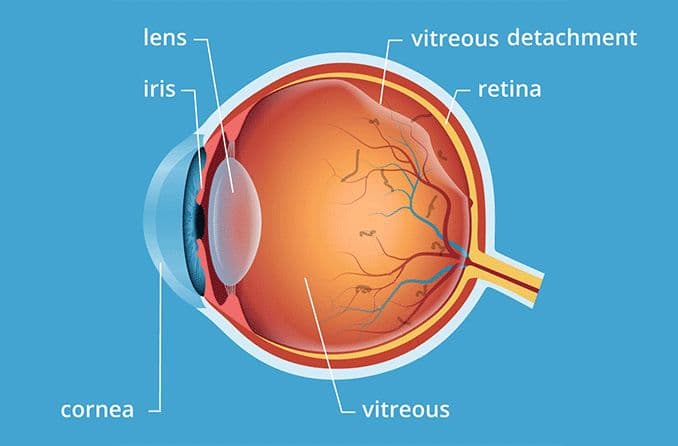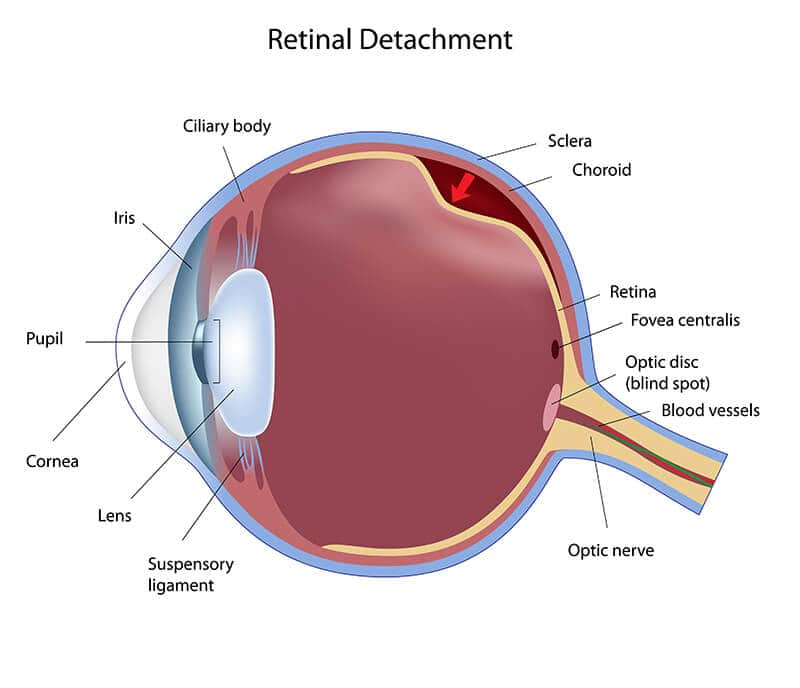What is Eye Jelly (Vitreous)? What is vitreous detachment?
The eye jelly is a substance found in the center of the eye.
In medical language, this jelly is called vitreous.

What Will We Learn?
What Is Vitreous Detachment?
The eye gel (vitreous) is very thick in adult humans.
As we age, this substance becomes liquid as a natural process.
The vitreous (eye jelly) is attached to the retina, the membrane of vision.
Over time, this substance turns from a hard state to a liquid state and begins to move into the eye.
In some cases, the substance called the vitreous becomes so loose that it pulls away from the retina behind it and becomes a problem.
In such disorders, a condition called “vitreous detachment” occurs in patients.
Vitreous detachment is the result of a natural life process and in some cases does not require treatment.
Some people may experience this condition in their 30s and 40s, but it is most common after age 50.
What Are The Symptoms Of Vitreous Detachment?
The major symptoms of vitreous detachment are a sudden increase in floaters in the eyes.
These objects can often be small dark spots or wavy lines floating in your vision.
When the vitreous within the eye separates, the filaments of the vitreous often create new shadows on your retina, which appear as floaters.
In some cases, patients may also notice flashes of light inside (peripheral) vision.
As mentioned above, this condition sometimes does not require treatment, but in some cases, it may require treatment.
In some cases, vitreous detachment can cause serious eye problems if left untreated.
A detailed eye examination is the only way to determine if the disease is causing a serious eye problem.
That’s why it’s important to see your eye doctor right away if you notice any signs of unusual changes in your eye.
If the disease is not severe, you will probably stop noticing the symptoms after a few months.
It should be remembered that the symptoms do not improve, you just have to live with these blackheads.
If the black spots are too much, these spots can be minimized with different surgery and laser methods.
If you have a lot of blackheads and floaters in your eye and you’re worried about it, talk to your doctor about it.

What Other Problems Can Vitreous Detachment Cause?
If vitreous detachment is not treated, it can cause serious eye diseases listed below:
1. Retinal Tear
In some cases, the vitreous fibers can be pulled, causing a hole in the retina.
If the holes formed in the retina are not treated, it can cause retinal detachment.
2. Retinal Detachment
Retinal detachment is a very serious eye disease that puts eye health at risk.
The vitreous detachment that occurs in the eye as we age moves the entire retina away from its normal position at the back of the eye.
If retinal detachment is not treated, it can cause vision loss.
3. Macular Hole
In some cases, this eye condition creates a hole in the macula (the part of the retina that controls your central vision).
The vitreous remnant remaining on the retinal surface contracts and pulls the macula and fovea outward.
As a result, hole-like tissue loss occurs.
Macular hole may also occur due to eye trauma, high myopia, intraocular inflammation, retinal detachment and other eye diseases.
The macular hole initially presents as distorted vision and blurred vision in the visual center.
Central vision is severely affected as the hole enlarges over weeks and months.
Patients with macular holes feel changes in the midpoint of their vision.
4. Macular Pucker
Macular pucker is a rare eye condition that can make your vision crooked or wavy.
Experts do not know what causes this disease.
Many people with macular stenosis have mild symptoms, and most people do not need any treatment.
But if the macular shrink makes daily activities difficult, you may need surgery to help you see more clearly.
In some cases, changes in the vitreous of the eye (eye gel) can cause a thin layer of scar tissue to grow over the macula.
Patients with vitreous detachment may experience this discomfort months and years later.
Macular shrinkage mostly develops due to posterior vitreous detachment.
This eye disease can occur not only in eye disorders such as vitreous detachment, but also in diseases such as retinal detachment, retinal vascular diseases or eye trauma.
Laser treatments or cryotherapy to treat retinal tears can unintentionally cause such eye disorders.
If the eye diseases listed above are not treated, they can cause vision loss.
If you notice signs of vitreous detachment, contact your doctor for a pending eye exam.

Am I At Risk Of Vitreous Detachment?
If you are 50 and over, you have a high probability of experiencing vitreous detachment.
Also, your chances of getting this eye problem increase as you get older.
Vitreous detachment is common in people aged 80 and over.
If you have eye problems such as myopia, this risk increases even more.
How Does The Ophthalmologist Check For Vitreous Detachment?
Your doctor will put drops in your eye.
This drop will cause your pupils to dilate and the back of your eye can be seen easily.
You may experience blurred vision for a few hours after the diagnosis, but don’t worry, this is temporary.
This examination is usually painless.
In some cases, doctors may apply some pressure to the eyelids for better inspection of retinal tears.
What Is The Treatment For Vitreous Detachment?
As mentioned above, this condition usually does not require any treatment.
If your vitreous detachment bothers you, and causes serious eye problems (retinal tear, etc.), your doctor may recommend treatment in such cases.
If floaters have been bothering you for a few months and are getting worse, if you have difficulty seeing clearly, your eye doctor may recommend a surgery called a vitrectomy to remove them.
Contact your doctor if you have any problems with vitrectomy surgery.
If you have dry eyes, you can check out this article.
